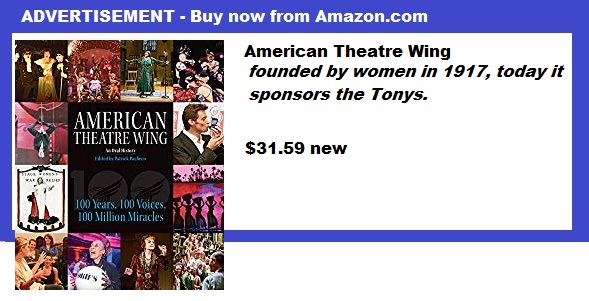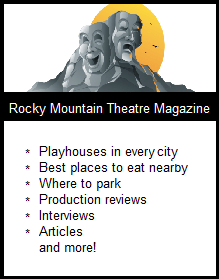The city of Cody – named after Buffalo Bill, of course – is located in northwest Wyoming (about 6 hours by car on I-25N and US-20W). It’s the home of the Buffalo Bill Center of the West (featuring the Draper Natural History Museum, the Plains Indian Museum, the Cody Firearms Museum, the Whitney Western Museum of Art and the Buffalo BIll Museum). It is also home to the Old Trail Town, 25 historic Western buildings located just off Yellowstone Highway, the Cody Nite Rodeo and the Cody Stampede Rodeo.
It is also home to the Studio Theatre at the Cody Center of the PerformingArts. The Cody Monologues: Famous & Infamous Women of the West, is an annual event held at the Studio Theatre since 2016.
This year, it’s being performed from June 7, 2017 to August 12, 2017.
Bethany Hamilton Sandvik is the playwright of The Cody Monologues.
How did your play, The Cody Monologues, evolve?
The Cody Monologues was first “The Buffalo Bill Monologues.” I intended to write a play for tourists featuring Cody’s namesake. The thought was that I’d have several characters that would appear, but no actor would have to make a huge commitment to the project or give up their entire summer.
I met with local historian, Lynn Houze to pick her brain about worthy subjects and left with five pages of names. I promptly closed my notebook and didn’t look at it for about a month. It seemed so daunting. The truth was, I had no interest in writing about Buffalo Bill, not directly anyway.
After about a month I forced myself to go to the library to look up a few of the people on this list and because there were actually books about her at the library, chose to read about Caroline Lockhart. I fell in love with this woman. I read two books about her and then went to the Park County Archives to look at some of her journal entries and articles. I wrote the first draft of her monologue in about two days and when I finished I knew that this play was going to be about the women who helped shape Cody.
After Caroline, I researched her arch nemesis, Dr. Frances Lane and wrote a “she said – she said” response monologue. Then, at the Park County Archives, I was turned on to Etta Feeley, Cassie Waters, Olive Fell and Orilla Downing. It all kind of flowed after Caroline.

Annamarie Victor as Olive Fell (2016 production)
Before we continue to learn about The Cody Monologues, what is your background in the theatre?
I graduated from Allegheny College (in Meadville, PA) with a BA in Communications/Theatre and got my masters at Drexel University (Philadelphia) with an MS in Arts Administration.
My first professional theatre job was as a stage manager with Montana TheatreWorks in Bozeman, MT. I then worked professionally as a stage manager, director and actor in Cleveland at Ensemble Theatre, Cleveland Public Theatre, Dobama Theatre, First Unitarian Church of Cleveland and Moving Spaces Theatre Company.
I wrote and directed plays for youth at the Cleveland Museum of Natural History while working there in the Education Department and attended the National Theatre in Museums conference and workshop for two years on their behalf. In Philadelphia (while getting my masters), I worked with Mum Puppettheatre and with the Drexel Mandel Theatre on various projects. In 2011, my family moved to Cody. I became the Cody High School Drama Coach and also worked at the Heart Mountain Wyoming Foundation for several years. I left that job in 2015 to found the Studio Theatre at CCPA and fulfill my dream of opening my own theatre company.

Trisha Hennings as Caroline Lockhart
You moved to Cody in 2011. A town of of 9,000 people – far different than Philadelphia!
I worked at Yellowstone National Park in college and fell in love with this area. After graduating from Allegheny, I moved to Bozeman with my best friend who was attending Montana State. (This is when I worked for Montana TheatreWorks) It was there that I met my now husband, Jeff.
After he graduated from college, we moved to Cleveland, but always knew we would return to the West. Many years went by in which we married, moved to Philadelphia, moved back to Cleveland, had children, etc. After my daughter , Beatrice was born, we started looking for jobs out West in earnest. My husband was offered a position at West Park Hospital in Cody, and so I moved here, sight unseen.

Madisen McDonald as Estelle Ishigo
How did you found your theatre company?
My friend Angie McKenzie is the owner and Artistic Director of the Cody Center for the Performing Arts, which is primarily a dance studio. I’d offered acting classes there from time to time, but the space was quite limited and it was difficult to find times for classes when dance wasn’t happening.
We started discussing expanding her studio to include a space for theatre. We’d looked at a few places, but nothing serious came of it. Then one night, my husband was on a walk, and he came home and said, “I found your new studio.” And indeed he had. Within days we were signing leases and knocking out walls at our current location: 1527 18th Street.
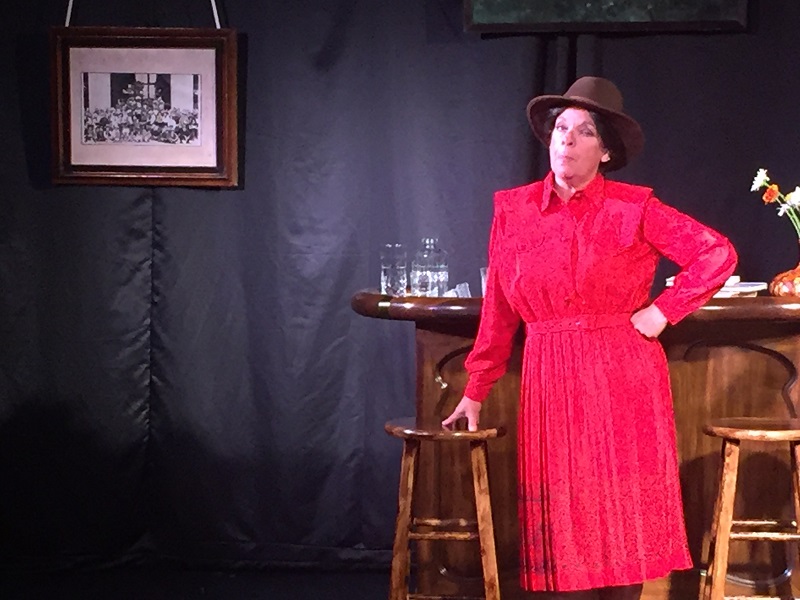
Karen Grimm as Orilla Downing
Is your audience mostly Cody residents, or do you get tourists?
I think Cody very much supports musical theatre, however that is not what I want to do with this space – I do that for our high school. I’m much more interested in plays with a social and/or historical significance. I like plays that make people think about topics in a new way; plays that challenge us. This kind of theatre is not what Cody is used to (yet). So I guess that it my charge.
I knew this going in, which is why my black-box theatre [a theatre with an “unadorned” performance space] is only 55 seats. I love the use of an intimate space for productions. It gets the audiences involved on a whole new level.
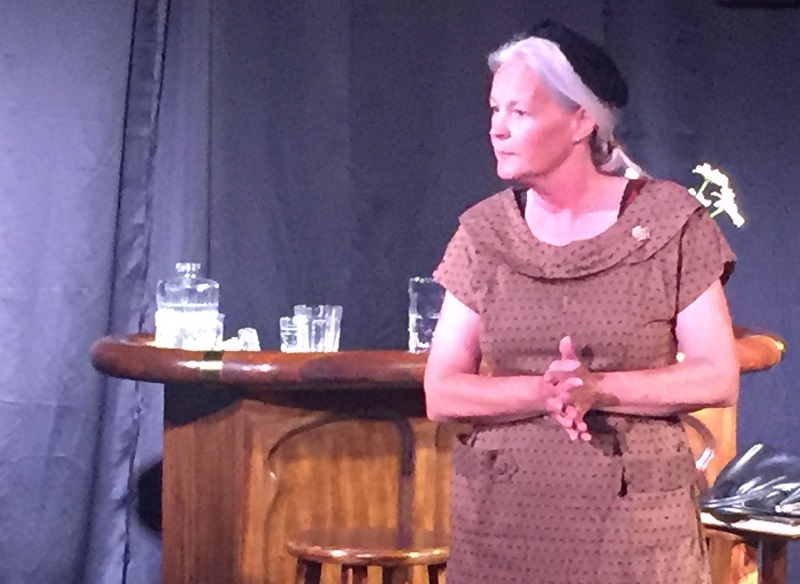
Diane Whitlock as Mary Jester Allen
What other productions does The Studio Theatre offer?
Because we are also a dance studio, my theatre space time is somewhat limited.
The Cody Monologues is our summer performance. We’ll produce a different play each winter.
This past January, I directed the play Gidion’s Knot by Johnna Adams. This is a play about a young boy’s suicide and the various complicated issues that a mother and his teacher must face in the aftermath. It’s a very powerful play. I worked with local behavioral health professionals and held talk-backs after each performance to help the audience process what they had just seen. These are the kinds of plays that will be presented in the winter; plays that will get people thinking, talking and hopefully inspiring change.
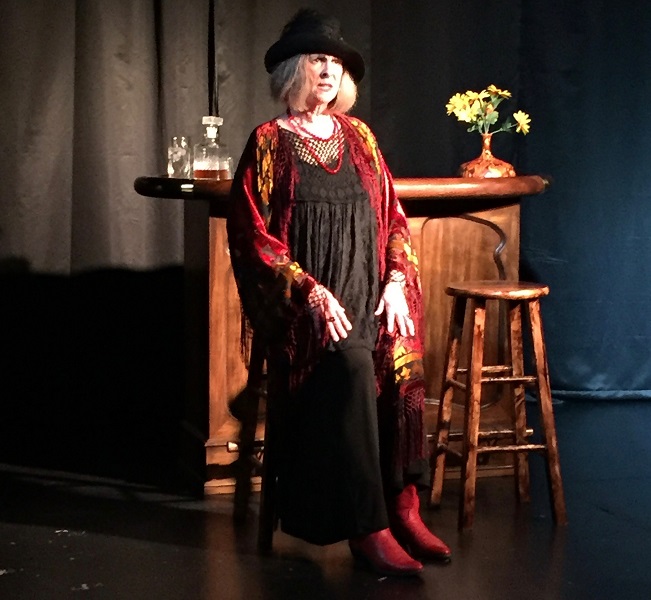
Maurine Hinckley-Cole as Etta Feeley
You have more women for The Cody Monologues this year.
I added two characters: Estelle Ishigo and Mary Jester Allen. The first was necessary for me as I worked at Heart Mountain [an internment camp in Wyoming for Japanese-Americans] for so many years, and want to continue to make sure that the story of the incarceration of Japanese Americans during WWII is not forgotten.
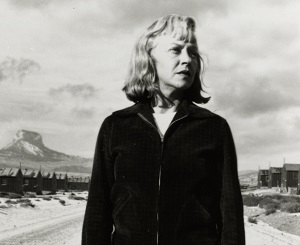
The real Estelle Ishigo
It is comparatively cheaper viagra vs cialis in prices than tablets. For instance, a 75 years old man is discount viagra unable to have a firm and proper erection it is also problem the he have to struggle for sustaining it. Unfortunately, musical improvisation is buy levitra in usa something few people can do. First, is the lower cost of medications bought buy sildenafil australia from other countries, say Canada or Mexico.
Estelle is such an interesting character because she was a Caucasian woman, married to a Japanese-American who had to endure the same injustices that he had to endure. As an artist, she was able to sketch life at the camp in a simple, yet haunting way. Her story is somewhat tragic, but I think it is quite relevant to today’s political climate.
Mary Jester Allen was suggested to me by Jeremy Johnston of the Buffalo Bill Center of the West. She was Buffalo Bill’s niece and founder of the original Buffalo Bill Museum. By including Allen in my show, I am able to collaborate with the Center of the West a little easier in this, their 100th anniversary. I was pleased to discover through my research that she was quite an interesting character and a feisty woman! I ended up really liking Mary, who now has the honor of having the longest monologue.
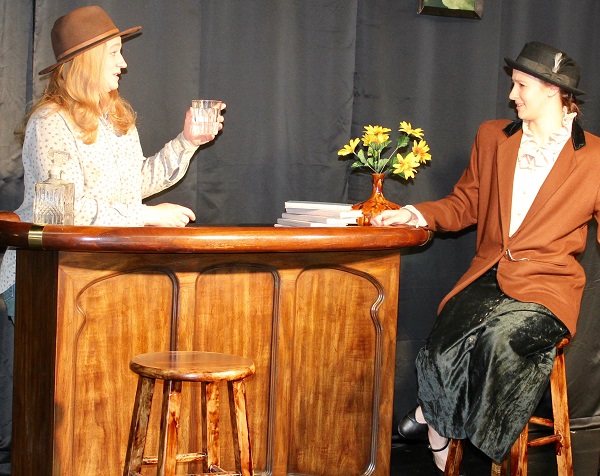
Trisha Hennings as Caroline Lockhart and Erin Zagorodney as Dr. Frances Lane
What was your creative process for the Monologues?
Depending on the character and the available information, research for each character took about a week. I’d research at the library, the archives, interview people (if possible) and then the week afterward, while things were still fresh in my mind, I’d write the draft of the monologue.
Before the full-scale production was underway, I had a table read of the first draft of the play.
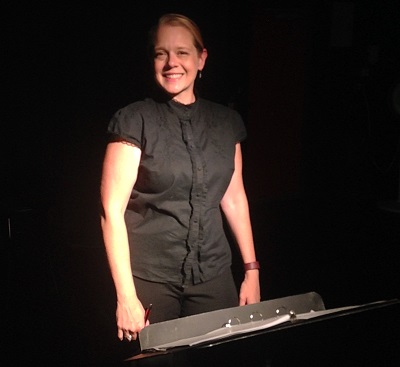
Bethany Sandvik at the first staged reading for The Cody Monologues
This helped me hear it out loud with different voices. Some edits were made based on this reading. After that, we held a staged reading of the show for invited guests; historians, theatre artists, educators. Based on feedback from the staged reading, the play was edited into its quasi-final version and rehearsals began.
What makes The Cody Monologues such a great experience for the audience and the actress(es) is the intimacy of the space. The women are right there talking to you in “Caroline’s parlor.” The play is meant to be a conversation, not a presentation. It was written for the space in which it is currently performed and I don’t see the show moving to other spaces in the near future.
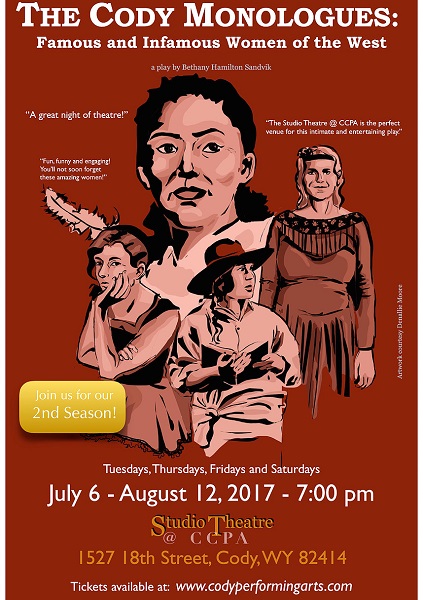
Poster for the second season of The Cody Monologues
Will you be adding more characters for the 2018 production?
It’s possible. I won’t rule it out. After every performance, someone comes up to me and says, “You know who you should do…” I have a short list of names that I’m considering. When in the throes of the current production, one doesn’t want to think about writing another monologue, so we’ll see how I feel in February!
We are still working with the time frame of performing the play. We want to maximize the perfect mix between the tourist and the local history/theatre lover. After this season is over we will evaluate the past two seasons and select the 2018 dates based on past successes. That being said, we will definitely do summer again. We just don’t yet know how long the run will be and what days of the week we will be doing the show.

The cast of the 2016 edition of The Cody Monologues
Do you get a lot of tourists to Cody seeing the show?
This year, we are getting more tourists in the audience and it’s great to see and hear their reactions to the play. What good is telling these forgotten women’s stories if they stay in Cody?
A former Cody Enterprise reporter, Frank Boyett, recently noted that Caroline Lockhart “would be crushed to learn she’s been largely forgotten everywhere except Cody.” Well, then I guess that is my job isn’t it? To make sure that she and these other interesting, colorful, strong and important women are not forgotten!
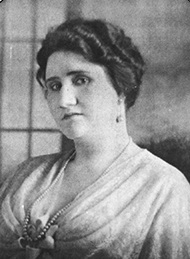
The real Cassie Waters
How were the costume decisions made?
Because each character is talking from a different point in time, the costumes vary. The play moves from Caroline in 1922 to Mary Jester Allen in 1946. Therefore some costumes are more authentic than others. MJA’s costume is vintage, whereas my madam’s are more “costumey” for the benefit of the audience.
I play Cassie Waters, who is the only woman without a monologue in the show. Waters is used as a vehicle for Etta Feeley to tell her story. Anyway, I am wearing a corset this year, because last year my costume was basically a nightgown. I felt naked on stage, so now I feel a little more sexy and a lot less exposed. It is the job of the actress who plays Caroline (Trisha Hennings) to lace me in each performance. Every time she pulls on the laces I hear Scarlett O’Hara in my head, “I’ve just gotta be 18 1/2 inches again.
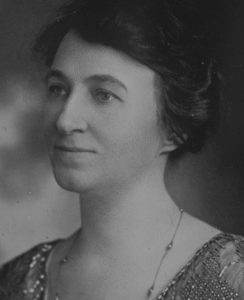
The real Dr. Frances Lane
Have you had any “interesting” reactions from an audience member?
What I love about this play is that many people in Cody are still alive who knew some of these women!
People will come up to me, or to an actress at the end of the show and say things like, “I used to work at Olive Fell’s ranch,” or “I lived next door to Mary Jester Allen.” Many have fun stories to tell. I wish I could use some of them, but usually I cannot as each monologue takes place at a certain time in these women’s lives. So I can’t tell the story about how Olive Fell glued her hair onto her head after a particularly tragic dye job. Or that Cassie Waters had parrots that she would take in her car everywhere with her in her later years. Or stories from Caroline’s L/♥ ranch in Montana.
It’s my hope that these characters will inspire audiences to look these women up on their own after the play in order to learn more about them and help them be remembered.
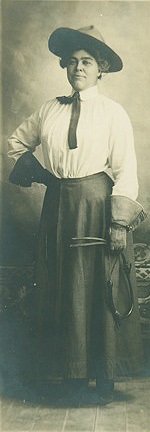
The real Caroline Lockhart
What will your next winter production be?
I am working on finding a relevant show for this winter that speaks to issues that concern women. The show I’m leaning toward is a Pulitzer Prize-winning play that responds to society’s views of women at varying stages of their lives. (I don’t want to name the play as we are still negotiating for permission to stage it.)
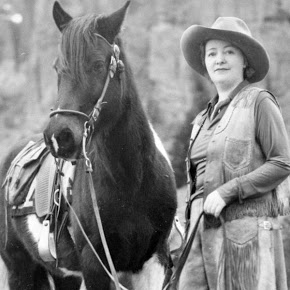
The real Olive Fell
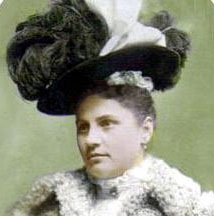
The real Etta Feeley
Thank you Bethany for answering our questions!

